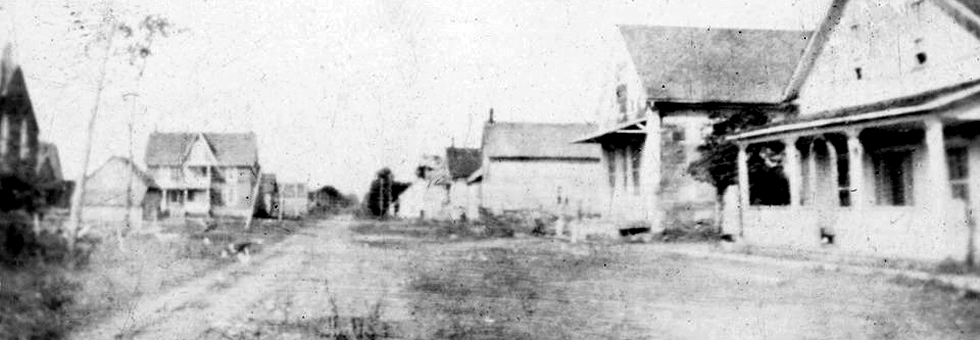Back in the 80s, a former Dunvegan neighbour and close friend hinted that parts of Glengarry could have been Alberta East. Robb and Joyce Cutts were weekenders from Montreal and lived where Lynn and Bruce MacGillivray live today. According to Robb, long before he moved here, a major player in the petroleum industry had leased the mineral rights on the property he and his wife purchased in 1978. At the time, I was focused on building a business and raising a family and filed Robb’s oil prospecting story in my Jedd Clampett file. You know, the guy on TV who “was shootin’ at some food, and up through the ground came a bubbling crude.” Until the other day, that is.
I was searching for articles in the Glengarry News from 1962 that referenced the founding of the Glengarry Pioneer Museum… or the Glengarry Scottish Museum, as it was called back in those days. In the process, I stumbled across two stories that confirmed Robb’s account of oilrigs in Glengarry was not a tall tale. A July 26th front-page story announced in bold type: “Dream Of Oil Just A Bubble…” The account went on to report that an unsuccessful 2,200 foot bore hole on Duncan M. MacCuaig’s farm near Laggan had been capped and the drilling crew was heading home to Kirkland Lake. It was also revealed that the driving force behind the flurry of oil exploration in this region was Imperial Oil.
A year earlier, the company had taken out ten-year mineral rights leases on 9,000 acres of farmland “in the McCrimmon – Laggan – Dunvegan triangle,” agreeing to pay farmers 75¢ an acre in year one and 50¢ per acre for each of the remaining nine years. The story concluded that it wasn’t yet clear if Imperial had completely given up on its search for oil or gas under the sod of Glengarry. However, one week later, the News reported that the leaseholders had received official notification from Imperial that further exploration would be unprofitable and that the farmers were being released from the terms of the agreement. And that’s why you don’t see a praying mantis-like crude oil pump slowly going up and down in Bruce and Lynn’s front field as you drive down Dunvegan Road.
Unintended consequences
Few people who live in the Dunvegan area today, other than those few born and raised here, would be able to tell you where Bonnie Hill is. It, like so many other features of the 9thconcession of Kenyon, was lost when Highway 417 was completed from Montreal to Ottawa. I suspect this four-lane thoroughfare was originally envisioned as a quick, convenient way for Federal civil servants to visit family and friends in Quebec. And, as such, would have taken a more direct route that followed the Ottawa River, just as the two-lane Highway 17 does today… if hadn’t been for the intervention of one man.
I was speaking to Claude Mainville last week about the 1970s era highway extension project and the effect it had on the farmers on the 9th concession, Skye Road… and Stewart’s Glen Road, where Claude grew up and took over the farm from his mother. Claude is of the opinion that the 417’s present path was due to the influence of Maxville-based Progressive Conservative politician Osie Villeneuve. Villeneuve was first elected to Queen’s Park in 1948, and was re-elected in 1951 and 1955. He served briefly as the region’s MP in Ottawa, but returned to the provincial arena in 1963 where he remained until his death in 1983.
Osie Villeneuve was never appointed to cabinet, but he was obviously a consummate politician who was devoted to the people who consistently put their mark next to his name on the ballot, election after election. Claude believes Osie Villeneuve lobbied hard to shift the course of Highway 417 to the south, knowing that the new route would, at long last, give the residents of Glengarry access to a high-speed road to the nation’s capital. He knew this would cut travel time from Dunvegan or Maxville from two hours or more down to 45 minutes.
However, like everything else in this world, access to speedier travel came at a price, and had unintended consequences. While the project’s planners did their best to minimize impact as the roadway slashed across the countryside, you can’t make an omelette without breaking eggs. Many farms on the 9th concession had their north ends amputated and were left with landlocked parcels on the other side of the super highway. This was the case with Claude Mainville, who had just purchased the family farm from his mom. When the 417 came through and bisected his land, the farm credit organization deemed his operation was no longer viable and refused his loan application. And this is just one of the 417 stories I’ve collected to date. Bonnie Hill was another. As a big bump on the landscape, it still exists… and I’ve always thought would make a boss Soapbox Racer track. But as a farm, though, it is no more. If you take a hard left turn just after taking the overpass north of Dunvegan, you’ll be on the far west end of Skye Road. The wonderfully steep hill (for these parts) straight ahead of you is Bonnie Hill.
-30-
